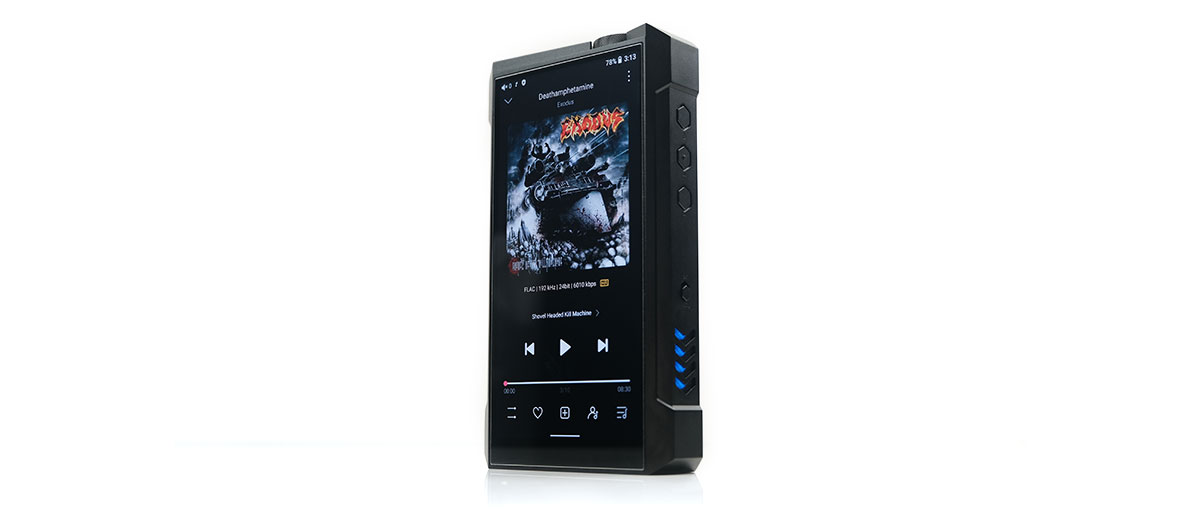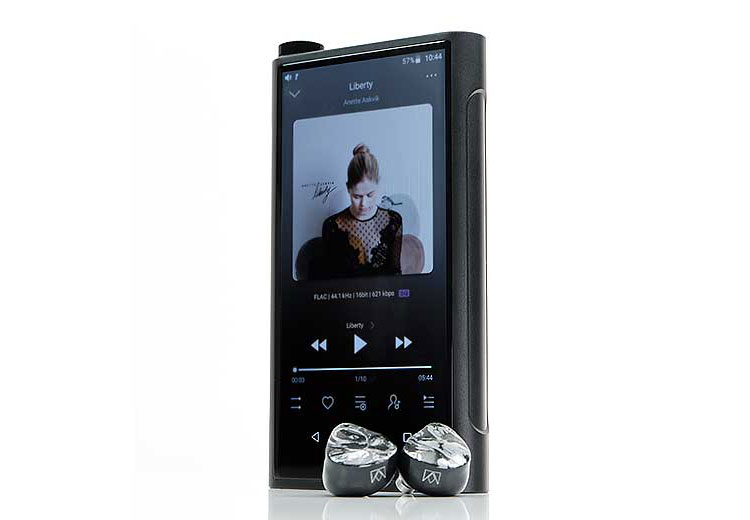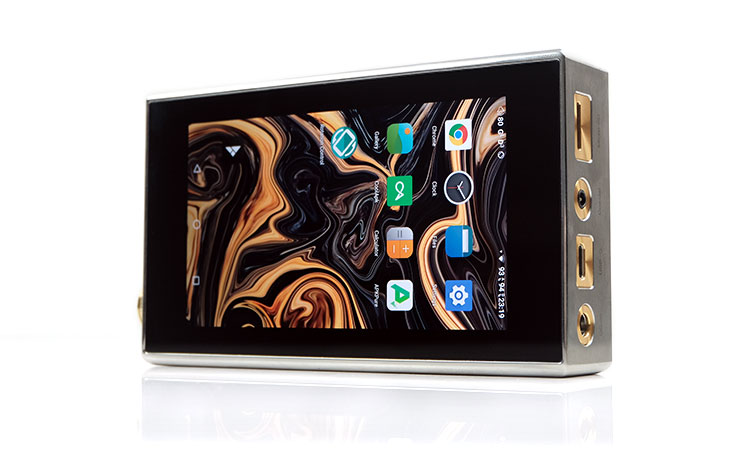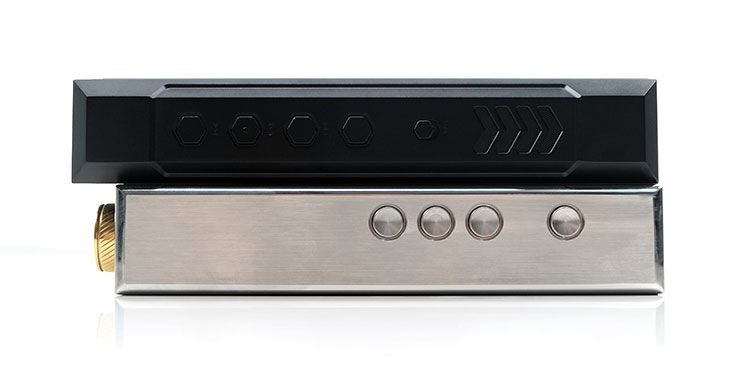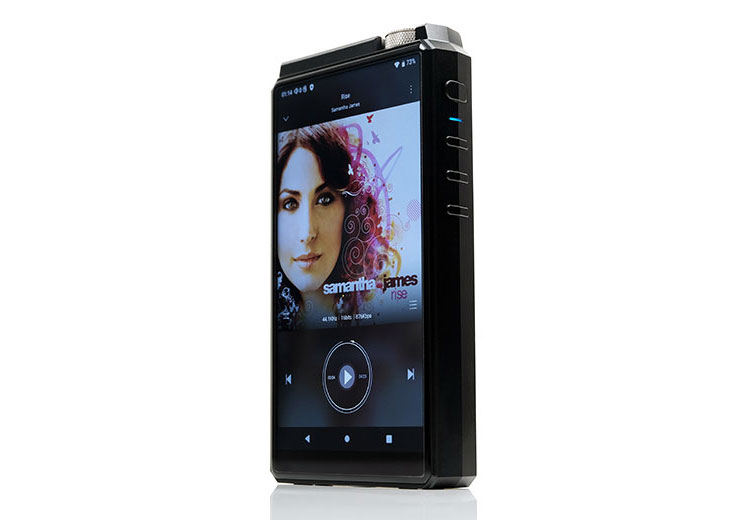Select Comparisons
All comparisons were completed using a JH Audio Jolene, Softears RS10, and the Abyss Headphones Diana V2.
FiiO M15
$1299
The M15 was launched in early-2020 and has now been discontinued and replaced by the M17 as the new flagship FiiO DAP. Its price point varied from region to region but we had it original at $1299 via FiiO’s AliExpress store which is a fair bit lower than the $1799 M17 price.
Technical
One of the main reasons for the end-of-life cycle of the M15 was its internal dual AK4499EQ DAC implementation. AKM’s fire and ending of this DAC product line mean chip supplies dried up pretty quickly for what was a well-regarded product line.
The M17 is the response to that, (as some of the lower-tier units), with a dual ES9038PRO implementation switching one company’s flagship DAC for another.
Some implementation aspects have remained, however, with the retention of the FPGA-controlled digital bridge with an XMOS XUF208 USB chipset and the dual NDK Femtosecond crystal oscillators for the time domain.
Code implementation for wired performance is not that dissimilar either with both devices capable of up to DSD512 and 32BIt/768kHz via a USB-DAC connection and up to DSD256 and 32BIT/384kHz natively. The two devices are also MQA capable at a maximum of 8X.
The big change is the OS, CPU, and RAM setup with the M15 now looking fairly dated with its older Samsung Exynos 7872 Soc, 3GB of RAM, and Android 7. The M17’s Android 10, 4GB of RAM, and Snapdragon CPU are far faster, modern, and better supported.
The other key change is the shift to a THX amplification stage which the M15 did not have. This time a customized THX AAA-788+ desktop-level output with a dual battery and DC mode power implementation.
That allows the M17 to hit up to 3W of balanced output power under DC mode and 1.5W into 32Ω using just the battery mode with plenty of gain control. Whereas the M15 tops out at 635mW balanced into a similar load level.
Design
No question which is the bigger DAP with the M17 measuring in at 156.8 x 88.5 x 28mm compared to the M15’s 134mm x 75mm x 18mm. It looks positively tiny compared to the M17 and also a fair bit lighter at 310g compared to 600g.
The design language has also changed considerably with FiiO chucking out their minimalist “Bauhaus’ rational design concept” of the M15 and expanding upon their more aggressive mech-styling first seen on the M11 series of DAP.
The materials are quite similar, both are CNC machined aluminum but the aesthetic of the M17 finish is much more aggressive with straight or angular lines, sharper corners, LED side grills, and that beautiful 3D mirrored finish on the rear.
The M15 is a little smoother in the hand with its rounded chassis but then it is much more of a DAP for hand use so it needs to be whereas the M17 is two-handed or on its own on the stand on a desk.
Features are all substantially upgraded on the M17 with a bigger more legible 5.99″ screen, dual USB input/outputs, dedicated coaxial, and the full suite of analog PO with a dedicated balanced and single-end LO also. The M15 does well with its selection but the lack of physical real estate place is a natural limiter on what it can offer.
Oddly enough, I kind of prefer the analog potentiometer of the M15 despite its jutting appearance. The M17 dial is a bit sunken for me and not as easy to operate whereas the M15 gold dial is much smoother but more aggressive in its steps. The M17 does have a more refined micro-step volume system with better gain control IMHO.
Performance
The M17 delivers a more powerful and resolving performance compared to the M15. The added headroom offered by the M17 once you start pushing up to demanding stuff like the Diana V2 is obvious. With monitors, you are going to hear a blacker background and a vibrancy that the M15 cannot match.
The coloration of these two DAPs is not that far apart, confirming that FiiO wants a clean reference sound as their in-house signature. However, the M17 definitely refines a few areas I felt the M15 was weaker in.
The first welcome change is the physicality and body of the performance, especially in the mids and treble. The M15 tended to play it safe with a midrange that stayed fairly neutral. It had a little bit of leanness in the timbre and also some upper mids percussive harmonic dissonance from a stronger treble overtone.
The M17 remains clean sounding but the notes have a much better texture, more body also, and that harmonic dissonance is gone so the improved energy is less fatiguing than the M15.
Instruments and vocals have that THX solid-state coloration but also offer an improved harmonic balance and an excellent fundamental from a low-end that is punchy and deep though not overly warm. I always enjoyed the M15 low-end and felt it offered some excellent layering but here it sounds softer and less dynamic.
The final impression is the dynamic range and power, especially with headphones such as the Diana V2. Even in battery mode, the M17 pulls out a much more expansive sound compared to the M15 which sounds narrower and comparatively compressed. In DC mode, simply no competition. The M17 obliterates the M15 for staging expansiveness and dynamic range.
iBasso DX300 MAX
$2290
The DX300 MAX is a limited edition release in 2021 and was awarded Best DAP in our Top Gear 2021 article late last year. It is priced almost $500 higher than the M17.
Technical
The MAX uses a dual AK4499EQ DAC which is the former flagship DAC from AKM. The M17 uses ESS’ desktop-class ES9038PRO, also in a dual configuration.
Natively they both decode at PCM at 32BT/384kHz and via USB-DAC, the M17 can go higher to 768kHz. Both will offer up to DSD512, however, natively the M17 is lower at DSD256 with DSD512 via its XMOS USB-DAC input.
The two DAPs can upsample MQA, however, the MAX does seem better equipped with a 16X rating compared to 8X on the M17.
Both use a Snapdragon 660 SoC though the MAX has an additional 2GB of RAM compared to 4GB inside the M17. Our AnTuTu results for both are virtually the same so you will only really see that 2GB advantage if you are a heavy task user on the MAX.
The M17 does have the fresher and better supported Android 10 which for me is key if you are looking for proper support for years to come. Android 9 on the MAX has far more limited direct support.
Both have a complex power supply but here the DC Mode on the M17 is used for output power optimization whereas the separate battery packs on the analog stage of the MAX are all about isolating the analog signal from the digital side.
The output power of the Discreet Class A MAX is excellent at 2.4W into 32Ω balanced with a dedicated 4.4mm LO rated at 4.4V. In battery mode, that is more powerful than the 1.5W of the M17 THX amp but lower than the M17’s 3W DC mode capability into the same load.
The M17 has additional LO for SE and for me a better gain structure but a slightly lower voltage rating at 3.9V balanced and 1.9V SE.
Design
The M17 is bigger but the MAX is heavier by 100g, primarily due to the battery pack system and the denser stainless-steel housing materials. I honestly never thought I would see a bigger DAP than the MAX just a few months later but here we are.
The aesthetic is very different. The MAX looks retro, minimalist, almost classical HiFi in its tone with a dash of gold accenting here and there. It’s classy, refined, and importantly got a few control buttons that the DX220 MAX lacked. I also much prefer the useability and control of the analog potentiometer of the MAX compared to the sunken M17 dial.
The M17 is the polar opposite with its aggressive urban mech-style design language, all-black tones to match, and plenty of physical control patterns compared to the MAX. It has a bigger and more legible screen also at 5.9″ FHD compared to the 1080p 5″ of the MAX. Of the two, the M17 feels better equipped for modern user demands.
Both are single slot microSD devices but the MAX lacks the additional USB-C 2.0 host expansion port and interestingly, OTG is not active on the MAX. It does compensate with better onboard memory at 128GB but if you have flash and HDD drives the M17 is the way to go.
Battery life on the MAX is better at up to 16 hours compared to around 10 for the M17 but when the DAC operation on the MAX is set to 8 channels it also drops down to around 10 hours. Charging on both is quick charge supported but bear in mind you do need the DC brick to charge the analog side of the MAX. That makes things a bit more complex for battery management.
Performance
In battery mode, the dynamic range of the DX300 MAX is just as good as the M17 though the additional gain levels of the M17 offer a bit more flexibility. Both DAPs have excellent power ratings and both can drive the likes of the Diana V2 very nicely indeed.
With the DC Mode activated though the M17 does have a very slight edge in terms of sheer power and low-end spaciousness. However, that perception might also have to do with the tuning bias of the DX300 MAX which I tend to find a bit more neutral on the low-end compared to the M17.
Both presentations you could describe as broadly reference-like rather than warm or rich sounding. However, the MAX is more on the high-fidelity side for me with a coloration that is sweeter, more gentile through the mids, and a little airier in the highs.
Whereas the M17 delivers a sound that is more physically robust with better depth and low-end spaciousness. The tone is drier, not as sweet-sounding but it is more energetic with a low-end that is further forward and more dynamic sounding.
I would pick the M17 if I need a strong fundamental with plenty of body and authority in the lower-mids instruments or vocals. It is a little harder-edged for me compared to the MAX, certainly more solid-state sounding also but its PRaT is excellent with plenty of drive. The MAX for me excels in staging space and clarity with a defter touch, or a lighter hand if you could call it that.
HiBy R8
$1899
Almost 18 months later after its initial launch, the R8 is still HiBy’s flagship DAP with a price point very close to the FiiO M17. On its debut, nothing came close to the modernity offered by the R8, and whilst many have caught up it is still a fairly robust offering in today’s market.
Technical
The R8 also uses a dual DAC implementation but the choice of AKM’s AK4497EQ is a step down from the flagship dual ES9380PRO used by the M17. This is also a discontinued chipset so it’s unlikely the R8 has much product life left in it.
What is on par with the M17 is the use of a Snapdragon 660 SoC and 4GB of RAM making the M17 a catchup device rather than a market leader. However, the M17 pushes ahead with the use of Android 10 whereas the HiBy’s R8 older Android 9 is now receiving only limited support from Google.
Still, the performance benchmarking is quite similar for both devices so both feel fast and snappy with clean installs and highly responsive touch-based IPS panels. HiBy’s own Music app also has a stronger feature set for me personally with MSEB DSP functionality.
Decoding-wise the R8 is on par with the M17 being able to offer up to DSD512 and 32bit/768kHz PCM decoding capability. Both use a dual oscillator system locked to 45.1584MHz and 49.152MHz for the time domain. One area the R8 is still ahead of the M17 is MQA upsampling with a 16X capability as opposed to 8X from the FiiO alternative.
Both devices can offer independent SE and balanced output for PO and LO though the I/O from the M17 is wider-ranging with 6.35mm and 2.5mm TRRS analog outs as well as LO for that additional 2.5mm output. It also offers dedicated coaxial in/out support whereas everything is via the single USB-C on the R8.
Output power is purely battery-based on the R8 with a strong 1W balanced capability. That is dwarfed by the M17’s 1.5W into the same 32Ω under battery mode and the huge DC mode 3W capability.
Design
Despite being what I would call a big DAP at 143*81*20mm and 426g, the R8 just shrinks when placed side by side with the 600g beast that is the M17.
Again, we do have to under the M17 is being pitched in a transportable class of player but for those wanting something more ‘pocketable’, the R8 is the likely choice based on size alone.
If you are looking for a bigger IPS panel, more I/O ports, and customizable physical button control then the M17 has the clear advantage as a transportable class desktop device.
The design language of both is more to the industrial side with the R8 going for a minimalist vibe whereas the M17 is definitely the busier of the two with its LED venting grills, recessed handling panels and 3D mirrored back panel. Both have recessed volume pots but the sheer depth of the M17 aluminum housing makes its version a bit thicker to use.
A bigger DAP means a bigger 5.9″ FHD screen on the M17 compared to the 5.5″ IPS 1080p screen on the HiBy R8 screen. Legibility on both is excellent but the better Android 10 font thickness and improved PPI of the M17 panel are superior.
Both are packing fairly substantial batteries with similar battery life. Heck, the R8 battery is bigger at 10000mAh compared to 9200mAh inside the M17. However, the M17 hybrid power management combined with the DC mode which can bypass the battery might mean better performance over the entire life cycle.
Performance
Whilst you can tell the battery mode of the M17 has a bit more headroom and power when required I actually thought the performance of the R8 Turbo mode was quite competitive with demanding headphones such as the Diana V2.
Where the M17 has the technical edge on battery mode is really is the amount of detail in the texture of the notes as well as more holographic presentation. Female vocals from the M17 delivered a bit more character, especially with breathy performances that felt smooth with the R8 but more life-like and resolving on the M17.
Switch to DC mode and it is a whole different ball game. The M17 dynamic range and vastly more immersive staging properties tower over the R8’s Turbo Mode performance. The M17 which really fills Diana’s presentation sucking you right into the performance whereas the R8 imaging is more gentile, laid back, and slightly in front of you.
The R8 is the more colored of the two DAPs for timbre. The M17 is more neutral in coloration but the excellent dynamics in our tested pairings deliver a stronger fundamental compared to the R8 The R8 has a warmer voluminous low end but lacks the same precise punch and definition of the M17.
It also pushes back a little on the mids in comparison to the M17’s synergy with both the Diana V2 and Jolene. Vocals are sweeter, with a bit more shimmer from an ethereal treble tone and also less body compared to the M17 equivalent. The M17 mids and treble balance is more neutral to my ear but also with better body and not quite as thinned out in the treble.
Our Verdict
The FiiO M17 is a huge DAP but with a huge sound. It is also probably one of the most complete portable audio devices I have reviewed to date. Both headphone and IEM users will find the M17 has both the deftness and the sheer grunt to satisfy both. DC Mode is a pure joy to use for demanding planar headphones in particular.
In a way, this is a desktop-class performer that still retains those critical delta-sigma DAP sensibilities with a black background, excellent channel balancing, and enough ports to appeal to almost every mainstream connection out there in the market currently.
The snappy Android 10 OS will also keep the M17 future-proofed to at least 2023 in terms of Google support and one step ahead of a lot of the competition’s now obsolete Android 9.
I find it hard to believe how FiiO kept this beast of a gadget well under $2k considering the features and performance it can deliver. Many DAPs out there cost more than double and are definitely more portable in terms of size but offer a fair bit less in terms of features.
FiiO M17 Specifications
- SoC: Qualcomm Snapdragon 660
- DAC: ES9038PRO x2
- Amplifier: THX AAA-788+
- Bluetooth: QCC5124
- USB receiver: XMOS XUF208
- Crystal oscillator: NDK femtosecond crystal oscillator x2
- Operation modes: Android/Pure Sound/USB DAC/Bluetooth receiver/AirPlay/Coaxial decoding
Output power
- ≥1.5W (16Ω/THD+N <1%)
- ≥3W (32Ω/THD+N <1%)
- ≥500mW (300Ω/THD+N <1%)
- Noise floor: ≤3.5uV (A-weighted)
- SNR: ≥123dB (A-weighted)
- THD+N: ≤0.0007% (1kHz/32Ω)
- Gain: low/medium/high/headphone mode/enhanced headphone mode (when powered through DC)
- Channel balance: L20~R20 (0.5dB per level)
- Recommended headphone impedance: 16~600Ω (single-ended)/16~600Ω (balanced)
- Dimensions: 6.17 x 3.48 x 1.1” (156.8 x 88.5 x 28mm)
- Weight: 1.3lbs (610g)
- Display: 5.99” (1080 x 2160) in-cell touch display
- Charging: supports QC3.0, QC4.0, PD2.0, and PD3.0 quick charge
- Battery capacity: 9200mAh
- Battery life: approximately 10 hours (single-ended), 8 hours (balanced)
- Charging time: approximately 4.5 hours (with quick charge)
- Standby: 1,000 hours
- Volume control: potentiometer knob or button controls
- Memory (RAM): 4GB
- Total storage/user available (ROM): 64GB/ approximately 46GB
- Expansion storage: single micro-SD card slot, theoretical support to up 2TB




